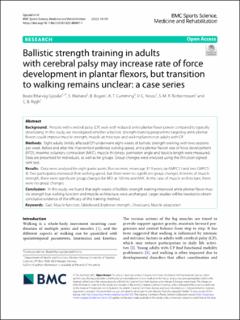| dc.contributor.author | Gjesdal, Beate Eltarvåg | |
| dc.contributor.author | Mæland, Silje | |
| dc.contributor.author | Bogen, Bård Erik | |
| dc.contributor.author | Cumming, Kristoffer Toldnes | |
| dc.contributor.author | Nesse, Vilde Cathrine | |
| dc.contributor.author | Torberntsson, Silje Marie Rydningen | |
| dc.contributor.author | Rygh, Cecilie Brekke | |
| dc.date.accessioned | 2022-09-30T07:24:01Z | |
| dc.date.available | 2022-09-30T07:24:01Z | |
| dc.date.created | 2022-06-24T11:29:44Z | |
| dc.date.issued | 2022 | |
| dc.identifier.citation | Gjesdal, B. E., Mæland, S., Bogen, B., Cumming, K. T., Nesse, V. C., Torberntsson, S. M. R., & Rygh, C. B. (2022). Ballistic strength training in adults with cerebral palsy may increase rate of force development in plantar flexors, but transition to walking remains unclear: a case series. BMC Sports Science, Medicine and Rehabilitation, 14(1). | en_US |
| dc.identifier.issn | 2052-1847 | |
| dc.identifier.uri | https://hdl.handle.net/11250/3022692 | |
| dc.description.abstract | Background
Persons with cerebral palsy (CP) walk with reduced ankle plantar flexor power compared to typically developing. In this study, we investigated whether a ballistic strength-training programme targeting ankle plantar flexors could improve muscle strength, muscle architecture and walking function in adults with CP.
Methods
Eight adults (mildly affected CP) underwent eight weeks of ballistic strength training, with two sessions per week. Before and after the intervention preferred walking speed, ankle plantar flexion rate of force development (RFD), maximal voluntary contraction (MVC), muscle thickness, pennation angle and fascicle length were measured. Data are presented for individuals, as well as for groups. Group changes were analysed using the Wilcoxon signed-rank test.
Results
Data were analysed for eight participants (five women, mean age 37.9 years; six GMFCS I and two GMFCS II). Two participants increased their walking speed, but there were no significant group changes. In terms of muscle strength, there were significant group changes for RFD at 100 ms and MVC. In the case of muscle architecture, there were no group changes.
Conclusion
In this study, we found that eight weeks of ballistic strength training improved ankle plantar flexor muscle strength but walking function and muscle architecture were unchanged. Larger studies will be needed to obtain conclusive evidence of the efficacy of this training method. | en_US |
| dc.language.iso | eng | en_US |
| dc.publisher | BioMed Central | en_US |
| dc.rights | Navngivelse 4.0 Internasjonal | * |
| dc.rights.uri | http://creativecommons.org/licenses/by/4.0/deed.no | * |
| dc.subject | gait | en_US |
| dc.subject | muscle function | en_US |
| dc.subject | glideboard | en_US |
| dc.subject | explosive strength | en_US |
| dc.subject | ultrasound | en_US |
| dc.subject | muscle adaptation | en_US |
| dc.title | Ballistic strength training in adults with cerebral palsy may increase rate of force development in plantar flexors, but transition to walking remains unclear: a case series | en_US |
| dc.type | Peer reviewed | en_US |
| dc.type | Journal article | en_US |
| dc.description.version | publishedVersion | en_US |
| dc.rights.holder | © The Author(s) 2022 | en_US |
| dc.source.pagenumber | 10 | en_US |
| dc.source.volume | 14 | en_US |
| dc.source.journal | BMC sports science, medicine and rehabilitation | en_US |
| dc.identifier.doi | 10.1186/s13102-022-00487-1 | |
| dc.identifier.cristin | 2034779 | |
| cristin.ispublished | true | |
| cristin.fulltext | original | |
| cristin.qualitycode | 1 | |

